Mention the word “Plasma” in the context of HDTV display technology, and most people’s minds are likely to turn to Panasonic or Pioneer, who have produced some of the most celebrated models over the last few years. Most people looking for bargains are fairly well served by smaller LCD TVs, which typically results in LG’s Plasma displays being unfairly ignored. Unlike Panasonic, who are not shy about communicating the generally superior quality of Plasma, and Samsung, who fly the LCD flag high, LG take a slightly more “tech-agnostic” approach and advise buyers to consider Plasma displays for affordable big-screen sporting fun, and LCD televisions for more general purpose usage.
<!-- google_ad_client = 'pub-2887677957235196'; google_ad_slot = '4990177225'; google_ad_width = 336; google_ad_height = 280; //-->
The LG 50PK590 is a 50-inch display which sits in the middle of the company’s Plasma TV lineup. Working our way down from the high end, what useful features are missing here? From comparing specifications sheets, nothing obvious. At this level, you’ll get a Full HD (1920×1080) panel, ISF calibration controls, THX certification, a DVB-T2 (Freeview HD) tuner, and 4 HDMI inputs. This leaves wireless connectivity, Bluetooth, a slightly sleeker design, and a “TruBlack” filter as the strongest points of models costing nearly twice as much.
At this rate, the LG 50PK590 is shaping up to be something of a bargain and at the very least, it should be a welcome break from all the Liquid Crystal that’s been passing through HDTVtest lately. Time to unbox the LG 50PK590 and put it through its paces!
Note: While we did not review the 60-inch LG 60PK590, most of the picture performance findings should still apply given its nearly identical specifications to the LG 50PK590.
The 50PK590 doesn’t feature the premium “INFINIA” branding reserved for LG’s higher-up Plasmas, so you won’t find a chic “one sheet of glass” design here. Instead, LG have gone for a design that’s much plainer, but every bit as functional. In fact, the LG 50PK590’s understated looks wouldn’t look out of place on a mid-range Panasonic display. The standout design feature is the so-called “RAZOR FRAME”, a marketing feature alluding to the fact that the frame surrounding the screen measures about 2.5cm on each side. This incredibly thin border makes the 50″ display feel larger.
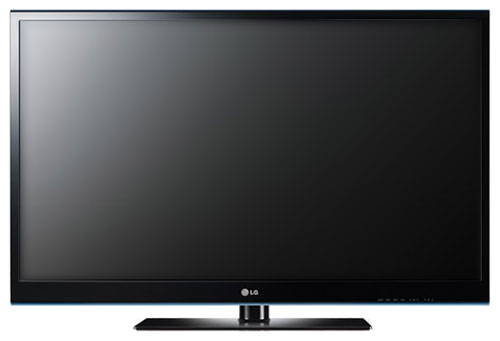
The stand is also styled in gloss black, and allows the LG 50PK590 plasma panel to swivel to the left and right. The only thing worth mentioning here is that we wish LG would add some recessed hand-grips to the back of its Plasma displays. These can be quite heavy, and lowering them onto the tabletop stand would be considerably easier (and less messy) if we didn’t have to grip the bezel whilst doing so. Still, this is a one-time irritance rather than anything severe.
The LG 50PK590 features 4 HDMI inputs in total. As is often the case, one of them is on the recessed side panel with the remainder being nearby, on the back of the TV. There’s also one set of Component inputs, a single SCART terminal, and a PC “VGA” input. The side panel also features 2 USB inputs and a set of Composite video/Stereo audio jacks. Naturally, there is also an aerial connector to feed the DVB-T/DVB-T2/analogue PAL tuner, for receiving TV broadcasts.
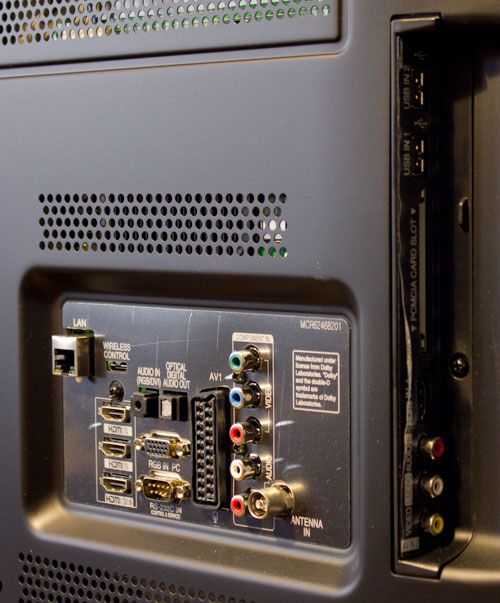 |
| Rear: 3 x HDMI, VGA, component, SCART, aerial, ethernet, RS232C & audio out Side: HDMI, Composite video, 2x USB, Common Interface |
LG’s recent HDTVs have featured very attractive user interface design. 2010’s models make a small cosmetic change, and feature purple and grey styling instead of the previous red and grey “company logo” colours.
Pressing the MENU button reveals a series of icons which are clearly labelled and visually described. Selecting one of these icons then takes the user to a more typical menu screen (pictured). As with previous LG displays, the menu on the 50PK590 is jam-packed with picture setup and calibration controls.
![[Picture] menu](https://www.hdtvtest.co.uk/news/wp-content/uploads/2018/04/hdtv_LG-50PK590_picture.jpg) | ![[Expert] menu](https://www.hdtvtest.co.uk/news/wp-content/uploads/2018/04/hdtv_LG-50PK590_greyscale.jpg) |
| [Picture] + Expert menu | 20-point Greyscale control |
The first LG-specific control here is called “Picture Wizard”, which launches a picture setup assistant. It displays built-in test patterns with on-screen instructions, which guide the user through the process of setting up Brightness, Contrast, Tint, Colour, and Sharpness. It’s an excellent touch, and helps users perplexed by the amount of controls to gain high picture quality from their new HDTV.
However, it may actually be unnecessary, because as the [Picture Mode] screen reveals, the LG 50PK590 features two THX viewing presets. Long-time readers will probably be familiar with THX presets from Panasonic’s Plasma displays, and their purpose is the same here: to bring high quality, accurate video with minimal effort on the part of the user. The THX preset is essentially what the 50PK590’s default settings should be – to borrow a phrase, “it just works”. Alongside this, and the usual dazzling but low quality showroom floor modes (“Vivid”, “Standard”, etc.), there are also two ISF-approved “Expert” modes, which unlock the full range of picture configuration options.
There’s also a “THX Bright Room” mode on the LG 50PK590, which uses a higher Contrast setting as well as a different Gamma curve in order to make the image more visible with ambient light present in the viewing room. Because the LG 50PK590 doesn’t feature any sort of specialised anti-glare coating, we recommend that prospective buyers treat their rooms to avoid sunlight falling on the plasma TV and washing out the picture.
The “Expert Control” menu contains most of the features we’ll be working with during calibration. In here, the most useful controls include a [Gamma] adjustment (which allows the user to pick from one of three built-in gamma curves), a [Film Mode] On/Off switch which allows the user to disable film cadence detection, Red/Green/Blue colour filter modes, 2-point and 20-point Greyscale calibration controls, and a Colour Management section which allows the user to control the intensity and tint of all six primary/secondary colours. LG were quick to recognise the added value that extensive calibration controls bring to their users, and in fact it is other manufacturers who have been playing catch-up in this area.
Note: Our LG 50PK590 review sample was calibrated using Calman Professional, the industry-leading video calibration software.
Before we tried to calibrate anything, we let the LG 50PK590 warm up and then measured the picture quality of the THX viewing mode. After all, the entire point of this picture preset is to provide accurate video for the average user, who (hopefully) wants to watch high quality images “as the director intended”, but probably doesn’t want to pay for video calibration – or more likely still, doesn’t know that such a service exists.
The results are below:
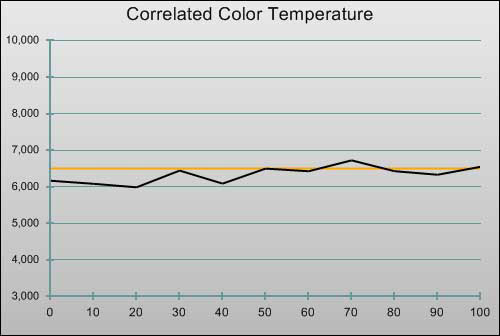 |
| Pre-calibration CCT in [THX Cinema] mode |
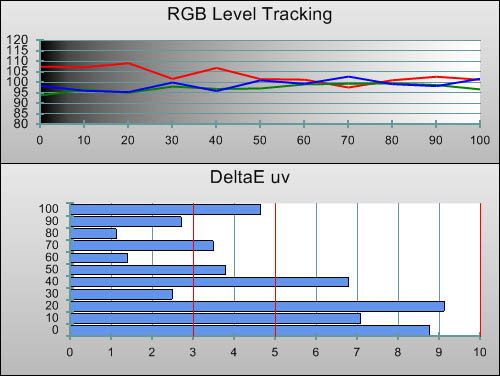 |
| Pre-calibration RGB tracking and delta errors (dEs) |
This pre-calibration result is fairly consistent with most manufacturers’ “Movie” or “Cinema” modes. As is often the case nowadays, for users who will not be having their HDTVs calibrated (something which probably becomes more and more likely the cheaper the display), this preset mode will provide a very satisfactory viewing experience. The correlated colour temperature hovered near enough around the desired 6,500K mark to make grey tones (and the colours overlaid on top of them) look realistic, without the characteristic “freezing blue” effect that uncalibrated displays tend to have.
![Post-calibration CCT in [ISF Expert1] mode](https://www.hdtvtest.co.uk/news/wp-content/uploads/2018/04/hdtv_LG-50PK590_post-cct.jpg) |
| Post-calibration CCT in [ISF Expert1] mode |
![Post-calibration RGB Tracking in [ISF Expert1] mode](https://www.hdtvtest.co.uk/news/wp-content/uploads/2018/04/hdtv_LG-50PK590_post-rgb.jpg) |
| Post-calibration RGB tracking and dEs in [ISF Expert1] mode |
LG offers two ways to fine-tune Greyscale tracking (and thus wring marginally more realistic pictures out of the 50PK590). The first is the standard “two-point” set of controls that’s now seen on almost every display, where the user can control the amount of Red, Green and Blue in both darker shades as well as lighter ones. The 20-point control works in the same way, but allows individual adjustment of each stimulus level in jumps of 5%. For example, instead of a single “low end” control which adjusts the overall balance in the 0-50% region, 20-point adjustment would allow peaks or dips to be ironed out at any point inbetween.
We started by using the standard 2-point control, and were able to improve Greyscale tracking further. Switching to 20-point mode allowed things to be levelled out even more, but the controls did not always act as expected (as is often the case with 20-point Greyscale calibration options). Often, we were unable to get the Green and Blue controls to do anything at all, leaving us to rely solely on the Red control to make improvements. We also had to be careful not to push the levels too far and introduce banding artefacts (which became visible on Gradient Ramp test patterns during our first couple of attempts).
We arrived at the end result depicted above after some amount of trial and error, and were very happy with the realistic look that it gave the on-screen pictures.
![Gamma curve in [ISF Expert1] mode](https://www.hdtvtest.co.uk/news/wp-content/uploads/2018/04/hdtv_LG-50PK590_post-gamma.jpg) | |
| Gamma curve in [ISF Expert1] mode | Corresponding gamma tracking |
Gamma tracking was very accurate on the LG 50PK590, allowing the tonal distribution from dark to light to look smooth and natural, without any under-represented (or grossly over-represented) shadows or highlights.
Out of the box, the [THX Cinema] viewing mode produced near-optimal colour. When we switched to the [ISF Expert1] preset, we initially used the “Blue Only mode” and a colour bars test pattern to set the basic [Colour] control as best we could by eye, to get an idea of how users attempting do-it-yourself calibrations without expensive calibration equipment would get on. This actually turned out to be a bad idea, because the LG 50PK590 has non-standard colour decoding which, by default, leaves blue under-represented on screen. In other words, trying to calibrate the TV with the “blue filter” technique rather than a measuring device resulted in the other five main colours being slightly too bright.
By default, the [ISF Expert1] mode featured a slightly widened and less accurate colour gamut (most notably, green was pushed out of the bounds of the HDTV Rec.709 standard). Using the built-in Colour Management controls in the “Expert Settings” menu, we were able to bring the colours closer into spec:
![Post-calibration CIE chart in [ISF Expert1] mode](https://www.hdtvtest.co.uk/news/wp-content/uploads/2018/04/hdtv_LG-50PK590_post-cie.jpg) |
| Post-calibration CIE chart with reference to HD Rec.709 |
![Post-calibration Luminance levels in [ISF Expert1] mode](https://www.hdtvtest.co.uk/news/wp-content/uploads/2018/04/hdtv_LG-50PK590_post-colour-lum.jpg) |
| Post-calibration colour luminance (coloured bars = targets; black bars = measured values) |
The colour management system on the LG 50PK590 allows the user to control Saturation, Hue, and Luminance, but not all independently. Each colour has a “Colour” and a “Tint” control, the “Colour” control being a combined Saturation/Luminance adjustment and “Tint” controlling the hue. More control would be ideal, especially in perfecting Yellow, which required us to undersaturate it to get its Luminance correct (you’ll notice that on the second chart, the amount of Yellow is basically perfect). After the calibration was done, though, everything on-screen looked suitably realistic.
Frankly, there was not a huge on-screen difference when we compared THX’s “one size fits all” calibration attempt to the tune-up work we did in the “ISF Expert1” mode. The biggest difference is that in the THX picture mode, all of the video controls are locked out – even basic adjustments such as Brightness and Contrast. When we did our own calibration, we had to raise the Brightness by 3 notches to reveal the optimal amount of shadow detail, because the THX mode (with its locked-in setting of Brightness: 50) was clipping video levels 0-20 into absolute black. Video black is defined as level 16, so when we calibrated the LG 50PK590, we made sure that everything above this level was barely visible, rather than being missing like it was in the THX mode. In addition, during our own calibration, we changed the Gamma mode to “High” and lowered Contrast slightly to achieve the smoothest Gamma tracking. We tested both modes with the newly transferred version of “Gladiator” on Blu-ray Disc (note: this is hugely superior to the old version, which recycled an old video transfer!) and noted that our own calibrated mode was slightly “punchier”, and had smoother highlight transitions than the THX mode.
| Dead pixels | One in bottom-centre, not always visible |
| Screen uniformity | Perfect |
| Overscanning on HDMI | 0% with [Aspect Ratio] set to “Just Scan” |
| Blacker than black | Passed |
| Calibrated black level | 0.09 cd/m2 |
| Black level retention | Stable in [THX Cinema] and [ISF Expert1] |
| Primary chromaticity | Very Good in [THX Cinema] and [ISF Expert1] |
| Scaling | Very Good |
| Video mode deinterlacing | Very effective jaggies reduction |
| Film mode deinterlacing | Failed 2:2 PAL (but passed 3:2 NTSC) |
| Viewing angle | Excellent (> 150°) |
| Motion resolution | 900 |
| Digital noise reduction | [Noise Reduction] effective, low panel noise |
| Sharpness | Below average: Forced edge enhancement |
| Image retention | Yes, but clears quickly |
| Posterization | Very mild, static |
| Phosphor trails | Less than Panasonic 2D displays |
| 1080p/24 capability | Accepts 1080p/24 video signal; no telecine judder |
| Input lag | 51ms compared to lag-free CRT |
| Full 4:4:4 reproduction | Yes |
| Default [Auto Power Save] mode | 227 watts* |
| Pre-calibrated [THX Cinema] mode | 296 watts |
| Calibrated [ISF Expert1] mode | 306 watts |
| Standby | 1 watt |
* In the out of the box configuration, the LG 50PK590 defaults to the “Auto Power Save” picture mode. This mode constantly varies the peak light output of the panel in order to match the room’s surroundings, and is essentially a more eco-friendly variant of a “Dynamic” mode, with blue-tinted Greyscale, high Sharpening, etc. As a result, the energy consumption of this mode is highly dependent on the TV’s surroundings.
All measurements taken with 50% grey screen. The power consumed by a Plasma TV varies according to the brightness of the pictures being displayed.
When we measured the LG 50PK590’s black level as hovering around 0.08 to 0.086 cd/m2, we were surprised, because darker areas of the image still looked somewhat more pleasing than on most LCD TVs we see with lower measured black levels (Samsung and Sony’s latest efforts have managed around 0.03 – 0.06 cd/m2).
The reason for this is uniformity. While this budget Plasma television cannot produce quite as dark a black as some of the better-equipped LCD TVs, darkness is consistent across the entire screen without any lighter patches, and also remains just as dark regardless of the viewer’s position (since Plasma HDTVs do not have any viewing angle issues). Keep in mind that LCD TV black level measurements are taken from the middle of the screen, with the measuring device at 0° facing the panel. The average black level seen by most LCD users will only be this good if they, too, are watching the panel face-on, and it’s not uncommon for the edges of LCD screens to be a little brighter.
In any case, we found the LG 50PK590’s black level to be very acceptable. While it’s not as impressive as Panasonic’s budget Plasmas (which can go down as far as 0.02 cd/m2), dark scenes did not look overly “misty”. Interestingly, LG’s own specifications state that the panel in this mid-range display is capable of the same contrast ratio as their flagship model (the PK990) – at least when ambient light isn’t taking its toll on the image.
Out of the four recent Plasma manufacturers (Pioneer, Panasonic, Samsung and LG), offerings from the latter two have suffered the most from a phenomenon known as image retention. The easiest way of describing image retention is to think of it as “temporary screen burn”: where a shadow of a static image (a TV channel logo, fixed on-screen clock, video game score counter, etc.) will persist on-screen for a while, before eventually disappearing. LG offer two screen cleaning modes on the 50PK590, “White Wash” and “Colour Wash”, which help alleviate the issue.
As it happens, all phosphor-based displays suffer from image retention. CRT TVs and all Plasmas exhibit this issue to some extent, but LG’s are especially susceptible. The fault is as much with broadcasters who abuse their viewers’ equipment as it is with LG’s technology, although it is possible to buy Plasma displays which are almost entirely resistant. We really wish that more channels in the UK would respect their viewers’ HDTV sets more and follow the American route of using transparent “watermark” type logos, rather than outputting solid-coloured eyesores.
During the review, the LG 50PK590 produced excellent motion clarity which was visibly better than any LCD TV (100hz/200hz assisted or not). The test charts on the FPD Benchmark disc allow us to review motion resolution in a more objective manner, but because Plasma displays have naturally excellent motion, it can often be quite difficult to give exact numbers while looking at the chart by eye (compare this to the performance of most LCD TVs, where the shortcomings are blatant). The LG 50PK590 displayed around 900-1000 clear lines with the scrolling chart, which is an absolutely excellent result – just what we’d expect from a Plasma HDTV.
When we checked out some over-the-air SD Digital TV broadcasts on the LG 50PK590, we were pleased with how they looked both before calibration (using the THX Cinema mode) and after. We did notice what appeared to be a shortcoming in the TV’s deinterlacing capabilities, because detailed high frequency areas like finely textured striped shirts and horizontal window blinds had a tendency to show flickering. In spite of this, the LG 50PK590 did well in the HQV test disc’s Diagonal Interpolation test.
Sadly, like Panasonic’s comparable Plasma TVs, the LG 50PK590 doesn’t detect the PAL 2-2 film cadence, which means that films input from a standard definition source (such as Freeview Digital TV or an older, non-upscaling DVD player) display with a small amount of flickering in finely detailed areas. This issue can be side-stepped by using a capable upscaling DVD player or other video pre-processor, although this isn’t an ideal situation.

Scaling quality is good, with SD and lesser HD (720p) material looking clear and crisp. Edges in the SMPTE RP133 Resolution Test Chart we use to detect scaling issues were clearly defined, and all of the pixel-thin horizontal and vertical lines were present, instead of being smudged into a single grey tone (something that older Panasonic plasmas were guilty of). There was a little bit of ringing around edges, but this is nothing that posed a problem during actual viewing.
One other thing to note is that LG’s “Noise Reduction” control was surprisingly effective in dealing with MPEG compression artefacts (blocking and mosquito noise). Although we’re now using Digital transmission in the UK, video noise can still creep into the chain from various sources, which hampers the MPEG compression process – especially given how many channels are crammed into the system. LG’s Noise Reduction control tackles both of these issues, as it is a combined spatial/temporal filter. This means that it effectively smooths out mosquito noise and blocky edges, as well as analogue-type moving background noise. Naturally, it does wipe out some detail, so many users may still prefer to leave it off.
During the calibration process (which we do primarily with 1080p/24 test patterns), we noticed that sadly, the LG 50PK590 partakes in the same forced edge enhancement as the LG’s premium 2010 model, the PK990 series. A quick recap for those who haven’t read about this elsewhere online: the TV performs its own additional Sharpening (edge enhancement) to the video signal, which adds “glowing”/”ringing” artefacts around high contrast edges. Lowering the TV’s Sharpness controls doesn’t get rid of the problem; instead it simply blurs the already sharpened image, further obscuring fine details. The only way to avoid the error (and instead to replace it with a very subtle but less noticeable blur around certain edges) is to label the input as “PC”, but this only works if the video type is 60hz, so there is no “get out of jail card” for 50hz-based European TV broadcasts or 24hz Blu-ray movies – in other words, the vast majority of content that those of us living in Europe (and Australasia) are likely to watch.
As it happens, the LG 50PK590 does have a control called “Edge Enhancement” inside its “Expert Setting” menu. The forced sharpening occurs even when this control is set Off; turning it On adds even more ringing. LG were notified of this issue several months ago, but as of yet no firmware update to remedy it has surfaced.
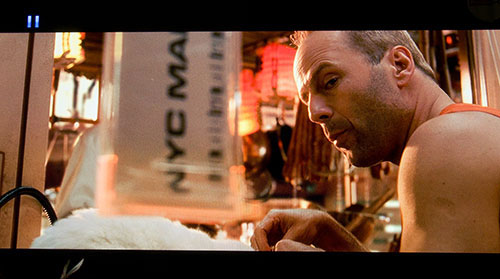
Fortunately, the rest of the news relating to the LG 50PK590’s performance with HD signals is good. Although we have unwanted video processing to contend with, the image quality benefits afforded by the Plasma panel are, of course, still present, and not all content will expose the ringing. There’s still deep blacks, an essentially unlimited viewing angle, clear motion, very accurate colour reproduction, and excellent Greyscale quality to enjoy.
Previous generation LG Plasma displays have performed fairly well for gamers, but 2010’s models drop the performance down a notch. We tried everything we could think of to reduce the input lag on the LG 50PK590, including labelling inputs as “GAME” or “PC” and using the “Game” picture mode, but the shortest delay we could get squeeze from the plasma remained a somewhat hefty 51ms. While this is generally acceptable for slower paced games, first person shooters (which there is no shortage of right now!) are best experienced on a HDTV with faster video processing. Of course, some users have reported that they find lag of 100ms or more acceptable, so your mileage may vary.
It’s been a while since we reviewed an LG Plasma HDTV here at HDTVTest, and since then, the company has taken both forward and backward steps with its plasma range. The black level performance of the 50PK590 is considerably better than previous LG Plasmas (which portrayed dark scenes with an unmistakable greyish mist), but unwanted video processing now means that 1080p HD material doesn’t look as naturally detailed as it does on the best Plasma screens. Additionally, input lag has taken a turn for the worse, which will irritate gamers.
With this said, LG forcing unwanted Sharpening on HD video signals is going to mean little for average consumers who just want a large-screen TV for a comparatively small amount of money. The trouble here is that a large Plasma TV is more likely to appeal to videophiles who will be annoyed by the artefacts that this process causes. In such a fiercely competitive market, we can’t understand why LG’s engineers would deliberately shoot themselves in the foot with this sort of meddling.
Our biggest complaints relate more to what the LG 50PK590 could have been (a no-holds-barred recommendation), rather than what it is. As it stands, it still offers tremendous value for money when you remember that for £700, you’re getting a large Plasma display that puts out a very respectable image. This sort of price range is typically the domain of LCD TVs, and to review a HDTV at this price level which is free of LCDs’ many flaws, is very refreshing. We don’t feel that the less-than-perfect HD performance should drop the LG 50PK590 down to “Average” level, because there is still a lot to like, especially given the plasma’s bargain pricing. It’s the fact that LG are not alone in the “budget Plasma” arena that stops it from receiving a hearty Recommendation, but buyers who want to go large on a budget are advised to check it out.
